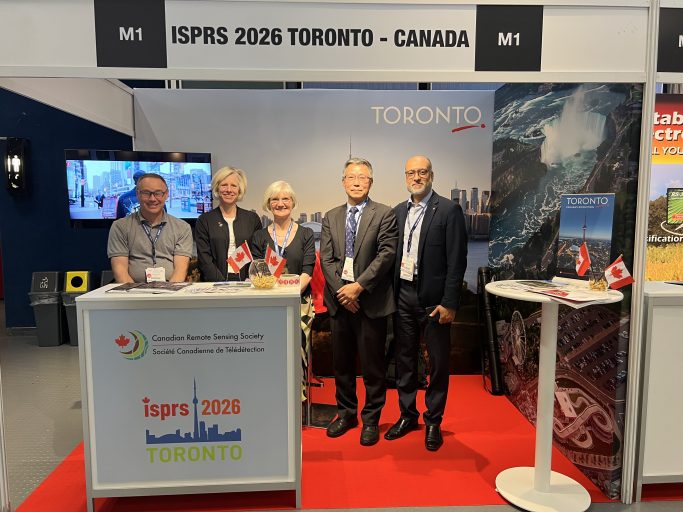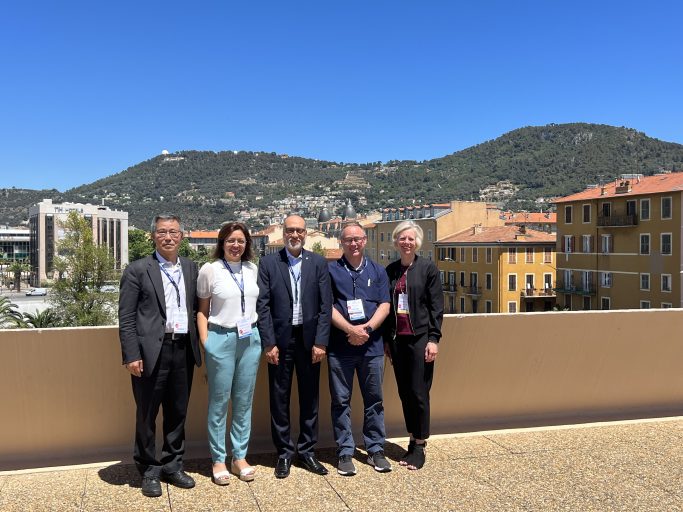By Kathy Nicolay, Leaders Circle Manager
The ISPRS Congress will return to Canada for the first time since 1972. This important international event will take place in Toronto at the Metro Toronto Convention Centre from July 4-11, 2026.
The International Society for Photogrammetry and Remote Sensing (ISPRS) is a non-governmental organization devoted to the development of international cooperation for the advancement of photogrammetry and remote sensing and their applications.
For 70% of international meeting bid wins, including this one, the participation of a representative from the Canadian member organization is required. In this case, it was Derek Lichti, Professor at the University of Calgary. Dr. Lichti had previously served two terms as Chair of the International Society of Photogrammetry and Remote Sensing (ISPRS) Working Group V/3 Terrestrial Laser Scanning. He also served 8 years as Editor-in-Chief of the ISPRS Journal of Photogrammetry and Remote Sensing.
The Leaders Circle partners with top thinkers, innovators and researchers like Dr. Lichti to secure international conference bids for Toronto. In turn, the ISPRS Congress and other international meetings like it gather experts and leave legacies of knowledge for their sector, as well and social and economic legacies for the region.

KN: Your field of work is very interesting; however, many may not know what it’s all about. In layman’s terms, can you explain the field of photogrammetry and remote sensing?
DL: Photogrammetry is the science of constructing a 3D geometric model of an object or a scene from imagery. Remote Sensing is information acquisition without physical contact and often refers to the science of inferring physical characteristics of a scene such as land cover.
KN: What was your role in bringing this congress to Toronto? What inspired you to lead the bidding process?
DL: My role was to lead the bid process. The formal title is Candidate Congress Director. My initial responsibility was to complete the preparation of the bid document. I was also responsible for promoting the bid through various media channels, coordinating volunteers and submitting the bid to the ISPRS Council. I presented the bid to the ISPRS General Assembly at the 2022 ISPRS Congress in Nice, France. Between the presentation (Monday) and the General Assembly (Friday) was an intense period of networking and lobbying. There were two competing bids.
Several factors inspired me to lead the bidding process. Canada has not hosted the ISPRS Congress in a long time. It is time to show the international community what we can do. Furthermore, the ISPRS is a society I truly love and have been deeply involved with in various leadership roles for nearly two decades. Congress Director is a good way to continue contributing to the ISPRS.
KN: This will mark the first time the Congress returns to Canada since 1972. Why do you think it is important to hold this congress in Toronto? What does this mean for Canada?
DL: The Congress is a huge event, taking place once every four years. The attendees it will attract to Toronto are top international experts in photogrammetry, remote sensing and spatial information sciences—all important aspects of the discipline called geomatics. Canada has long been a global leader in geomatics and the Congress will give us a chance to showcase our achievements, both nationally and internationally.
KN: We know that a lot of work goes into submitting an international meeting bid. Could you list the names of the organizations and individuals that put forward the Toronto bid?
DL: The bid was officially submitted by the Canadian Remote Sensing Society – Société canadienne de télédétection (CRSS-SCT), which is the Canadian Ordinary Member of the ISPRS. Many individuals from the CRSS-SCT—volunteers like me—contributed to the bid preparation: Ahmed Shaker, Songnian Li, Costas Armenakis, Brigitte Leblon, Mir Abolfazl Mostafavi, Des Power, Gordon Staples, Bob Ryerson, Steve DeRoy and Shabnam Jabari.

KN: Specifically, who did you collaborate with to submit the bid?
DL: Angela Jeffries from Destination Toronto and Rahul Shah from the MTCC were instrumental in preparing the bid. Both were extremely supportive and helpful. They successfully applied for a Convention Development Fund grant that will be a big boost for the Congress. Angela even attended the 2022 Congress in Nice. Her support was a big factor in our success.
KN: At times, government officials will submit support for a bid. Did you get support from municipal, provincial and/or federal government? Other institutes?
DL: We had support from the Prime Minister, the Premier, the Mayor, several federal government agencies as well as many Canadian geomatics companies and non-profits. Twenty-two excellent supporting letters were included with our bid submission.
KN: What are some of the topics to be covered at the congress?
DL: The scope of topics covered is very broad. At a high level, ISPRS scientific activities are divided into five key areas: sensors; photogrammetry; remote sensing; spatial information systems; and education and outreach. Some of the leading-edge research topics that will be featured include, but are not limited to, artificial intelligence and machine learning; earth, ocean, ice and atmospheric monitoring; disaster prevention; digital construction and building information modelling; and digital teaching and training methods.
KN: What impact will this congress have to your field in photogrammetry and remote sensing?
DL: The Congress is a fantastic opportunity in several regards. First, the Congress theme “From Imagery to Understanding” encapsulates very well the role of ISPRS scientific activities. Imagery, in its many forms, is our primary data source. This distinguishes us from other disciplines and defines to a great extent how we work. Understanding can be interpreted as the end goal of the work we do: achieving greater awareness about the planet and its diverse peoples to meet the many challenges we face.
Second, we have planned a legacy project for the Toronto Congress that will have lasting impact. In addition to the many high-quality plenary and scientific presentations, we plan for a special session devoted to the creation of materials that can be used by the ISPRS community to better promote, to funding agencies and others, the important role that we play in the world’s economic and environmental activities.
KN: What is your estimate on attendee registration numbers?
DL: We plan for an in-person event and hope for in excess of 2000 attendees.
Any other comments you would like to make?
DL: I have three priorities for planning the showcase event of the ISPRS:
- Scientific program quality excellence
- A large group of deeply engaged sponsors and exhibitors
- A memorable conference experience for participants
Thank you!
To learn more about the Leaders Circle visit theleaderscircle.ca